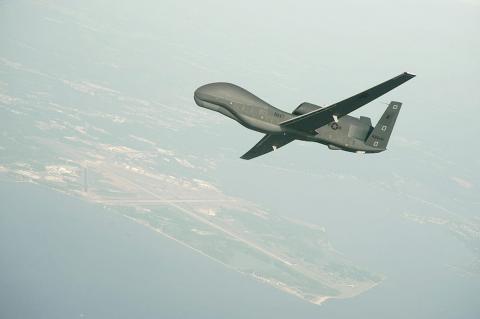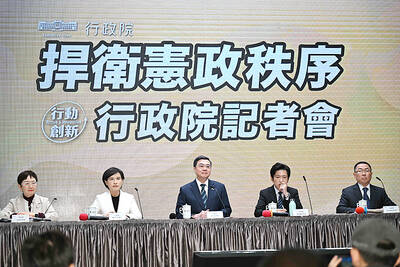The US will use its most advanced unmanned reconnaissance aircraft to monitor Chinese activity in waters surrounding the Diaoyutai Islands (釣魚台), the object of an acrimonious dispute between Beijing and Tokyo, Japanese media are reporting.
The decision was made during a meeting between Japanese Defense Minister Satoshi Morimoto and US Secretary of Defense Leon Panetta at the Pentagon on Sunday, NHK and the Yomiuri Shimbun said, adding that the drones would also conduct surveillance around Okinawa.
At least three unarmed Northrop Grumman RQ-4 Global Hawk drones have been deployed at Andersen Air Force Base on Guam since September 2010, bolstering the operational intelligence capabilities of US forces in the Asia-Pacific.

Photo: Reuters
Operating at an altitude of about 18,000m, the RQ-4 provides near-real-time, long-range intelligence, surveillance and reconnaissance imagery by means of a high-resolution synthetic aperture radar. It played a role in damage assessment following the disaster at Japan’s Fukushima Dai-ichi nuclear power plant in March last year.
Amid rising tensions between Japan and China over the disputed islets, the Japan Maritime Self-Defense Force has mostly relied on P-3C “Orion” surveillance aircraft to monitor Chinese naval activity in the area.
Taiwan also claims sovereignty over the islands.
Tetsuo Kotani, a fellow at The Japan Institute of International Affairs in Tokyo, said the deployment sends an important message.
“One of the urgent issues for the US-Japan alliance is to enhance intelligence, surveillance and reconnaissance [ISR] cooperation,” he told the Taipei Times yesterday. “The Global Hawk can serve as a symbol of allied ISR cooperation.”
“This is an important step for the alliance and sends a strong message to Beijing that Washington stands firmly with Tokyo,” he said.
Although the US does not officially take a position on the sovereignty dispute, some believe the Diaoyutais fall within the scope of Article 5 of the US-Japan Treaty of Mutual Co-operation and Security.
However, Kotani said Beijing should not misunderstand the real message.
“This is US reassurance to Japan. As long as Japan is reassured by the US, Japan does not have to take provocative actions vis-a-vis Beijing over the Senkakus,” he said. “No country wants to increase the tensions.”
The Diaoyutais are known as the Senkaku Islands in Japan.
During Sunday’s meeting, Panetta and Morimoto also agreed to explore eventual revisions of the Guidelines for Japan-US Defense Cooperation, which govern cooperation between the Japan Self-Defense Forces and the US military during crises.
Passed in 1978, the guidelines were substantially revised in 1997 in response to the North Korean nuclear program.
“We shared the view that it’s important to jointly study and discuss [security matters], taking into consideration changes in the security environment and what Japan-US cooperation should be,” Morimoto told a press conference.
According to the Yomiuri Shimbun, the review will focus on defense cooperation on the Nansei Islands in response to Chinese military expansion and increasing activity in waters surrounding Japan, as well as North Korea’s nuclear and missile development and post-disaster cooperation.
No specific procedures or timeline for the review were discussed.

The US government has signed defense cooperation agreements with Japan and the Philippines to boost the deterrence capabilities of countries in the first island chain, a report by the National Security Bureau (NSB) showed. The main countries on the first island chain include the two nations and Taiwan. The bureau is to present the report at a meeting of the legislature’s Foreign Affairs and National Defense Committee tomorrow. The US military has deployed Typhon missile systems to Japan’s Yamaguchi Prefecture and Zambales province in the Philippines during their joint military exercises. It has also installed NMESIS anti-ship systems in Japan’s Okinawa

‘WIN-WIN’: The Philippines, and central and eastern European countries are important potential drone cooperation partners, Minister of Foreign Affairs Lin Chia-lung said Minister of Foreign Affairs Lin Chia-lung (林佳龍) in an interview published yesterday confirmed that there are joint ventures between Taiwan and Poland in the drone industry. Lin made the remark in an exclusive interview with the Chinese-language Liberty Times (the Taipei Times’ sister paper). The government-backed Taiwan Excellence Drone International Business Opportunities Alliance and the Polish Chamber of Unmanned Systems on Wednesday last week signed a memorandum of understanding in Poland to develop a “non-China” supply chain for drones and work together on key technologies. Asked if Taiwan prioritized Poland among central and eastern European countries in drone collaboration, Lin

NO CONFIDENCE MOTION? The premier said that being toppled by the legislature for defending the Constitution would be a democratic badge of honor for him Premier Cho Jung-tai (卓榮泰) yesterday announced that the Cabinet would not countersign the amendments to the local revenue-sharing law passed by the Legislative Yuan last month. Cho said the decision not to countersign the amendments to the Act Governing the Allocation of Government Revenues and Expenditures (財政收支劃分法) was made in accordance with the Constitution. “The decision aims to safeguard our Constitution,” he said. The Constitution stipulates the president shall, in accordance with law, promulgate laws and issue mandates with the countersignature of the head of the Executive Yuan, or with the countersignatures of both the head of the Executive Yuan and ministers or

CABINET APPROVAL: People seeking assisted reproduction must be assessed to determine whether they would be adequate parents, the planned changes say Proposed amendments to the Assisted Reproduction Act (人工生殖法) advanced yesterday by the Executive Yuan would grant married lesbian couples and single women access to legal assisted reproductive services. The proposed revisions are “based on the fundamental principle of respecting women’s reproductive autonomy,” Cabinet spokesperson Michelle Lee (李慧芝) quoted Vice Premier Cheng Li-chiun (鄭麗君), who presided over a Cabinet meeting earlier yesterday, as saying at the briefing. The draft amendment would be submitted to the legislature for review. The Ministry of Health and Welfare, which proposed the amendments, said that experts on children’s rights, gender equality, law and medicine attended cross-disciplinary meetings, adding that